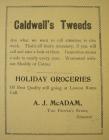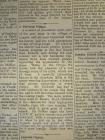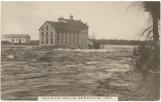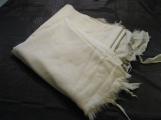1
The Teskey family continued operating the Mississippi Woollen Mills in Appleton right up to about 1899 when the mill was sold to Mr. Thomas Boyd Caldwell of Lanark (Boyd Caldwell & Co.). The Caldwell family were originally lumber barons in Lanark Village and during the late 19th century had entered the woollen industry. Appleton's woollen mill added to the Caldwell's business of mills in Lanark Village and later Perth.2
Almonte Gazette Clipping: Advertisement for Caldwell's Tweeds at A.J. Adam's Store, Almonte7 January 1898
Almonte, Town of Mississippi Mills, Ontario, Canada
 Credits:
Credits:North Lanark Regional Museum, Almonte Gazette
3
Thomas Boyd Caldwell came from a business family. In Carleton Place his father had operated a sawmill while in Lanark Village the family operated a sawmill, a woollen mill and a general store.After his father's death in 1888, Thomas Boyd Caldwell continued to operate Boyd Caldwell & Co. in Lanark Village. In 1899 he expanded the business to include the woollen mill in Appleton and later he purchased a woollen mill in Perth.
Thomas Boyd's oldest son Boyd A.C. Caldwell (1879-1949) helped managed the mills in Lanark while his second son Donald William Falconer Caldwell (born 1882) managed the woollen mill in Appleton.
4
Almonte Gazette Clipping: Lanark Village4 November 1898
Lanark Village, Lanark County, Ontario, Canada
 Credits:
Credits:North Lanark Regional Museum, Almonte Gazette
5
Clip from the Almonte Gazette November 4, 1898, discussing the Caldwell mills in Lanark Village."A Thriving Village. A number of Almonters spent part of the past week in the village of Lanark, and all were impressed with the beauty and the solid appearance of that thriving burgh. No place in the district has made greater proportionate progress in the last decade than Lanark, and during the past summer not a few handsome residences have been erected, greatly improving the appearance of the place. While in the village the writer had the pleasure of a run through some of the mills, which are all busy. A specially interesting feature in the Aberdeen Mills is the carpet weaving department, a branch that proves attractive to every visitor. Mr. Caldwell has had a brisk business in the carpet line thus far, and it will doubtless expand with the coming years. The more pretentious mills of Messrs. Boyd Caldwell & Co. - famous for their high-grade tweeds, rugs, etc. - are running full time, with a good grist of orders ahead. On Friday night the local A.O.U.W. gave a concert to a packed town hall with a program equal to what is put on in the cities. Lanark people are proud of their village and its attractions, and stick to it most loyally. Right they are too."
6
The turn of the century saw many changes in Appleton. Thomas Boyd Caldwell took ownership of the mill and began modernizing the mill. In order to increase efficiency a more reliable source of power was needed. In 1901 Boyd Caldwell & Company hired electricians to wire the mills and install an electric turbine generator using water power. This was probably the first electric power in the village of Appleton.7
Caldwell Woollen Mills operated using electricityCirca 1900-1937
Appleton, Town of Mississippi Mills, Ontario, Canada
 Credits:
Credits:North Lanark Regional Museum (2011.15.2)
Donated by Wendy Leblanc
8
The flowing waters of the Mississippi River, Ottawa River, Bonnechere River, Madawaska River and the Rideau River of the Ottawa Valley created a booming woollen industry in the area. Woollen mills and carding mills were built along the river banks to capture the water's power.This Ottawa Valley woollen industry depended on sheep to supply the necessary wool for production. By the late 1800s the main local breeds, bred for wool were the Leicester, Cotswold and Lincoln. These breeds produced longer and finer wool fibres compared to other breeds that were bred primarily for the meat market.
Wool for the woollen mill came from two sources: locally farmed sheep and the international market. Internationally most of the wool came from Australia, New Zealand and South America. These countries had large farms devoted to the wool industry compared to Eastern Ontario where mixed farming was still predominant.
9
Andy Baird with raw wool at the Collie Woollen Mills, photo by Malak Karsh1945-1946
Appleton, Town of Mississippi Mills, Ontario, Canada
 Credits:
Credits:North Lanark Regional Museum (2012.79.12.6)
Photographer: Malak Karsh
Donated by Eleanor Wright & Irene Dunn Thompson
10
Some of the wool definitely came from local markets. The Tweedsmuir History of Appleton documents the production of local wool for the Caldwell mill. An Appleton Tweedsmuir History article submitted by Anna and Cecil Turner April 10, 1976 recounts:"In the days when the mill at Appleton made 100% pure wool blankets (Caldwell's) the wool was bought from the local farmers (much of it). Some of the women would keep a fleece of wool to make their own woolen comforters, using teased wool as a filler. The price of wool was higher if the wool was washed. To do this, many farmers drove their sheep down to the river in the spring and washed them there. (...) this wool had the oil restored to it and was preferred by the mill workers to the fleeces that were washed and dried after shearing. Hence the 'river washed wool' brought a better price. Of course dust came back into the wool on the journey home but the wool could still be sold as washed wool. Few if any sheep were drowned."
11
Wool Blanket produced at the Woollen Mill in AppletonCirca 1862-1960
Appleton, Town of Mississippi Mills, Ontario, Canada
 Credits:
Credits:North Lanark Regional Museum (2007.19.138)
12
World War One changed the face of Appleton as local men and women joined the Canadian Forces offering their service for their community and country. On the home front the community raised money for the war effort, sent care packages and supported wartime production at the mill.WWI created a boom in business at the Caldwell Woollen Mills. Throughout the war the mill operated at full capacity with increased staff and increased hours. The wartime effort wasn't unique to Appleton, woollen mills across Eastern Ontario and Quebec all worked hard to fill military contracts for blankets, uniforms and other textiles.
In the book Historical Sketches of Appleton, by Jack Brown notes that in, "1918: The Caldwell Woollen Mill is very busy making puttees. They send out about 1,500 a day to the women of the village to finish." Puttees were a part of Canada's WWI military uniform - a cloth wrapped around the soldier's calf muscles.
13
When the war finally ended, the community honoured those who died and those who served. On June 20, 1919 the community hosted a Reception for Returned Soldiers at the community Hall. The Almonte Gazette of Friday June 27, 1919 documented the evening's events:"Appleton Welcomes Her Soldiers:
The reception given on Friday evening, June 20th, to our Returned Soldiers, was a grand success. The weather was ideal, everything around glorious world seemed to speak joy, gladness and peace to everybody. It certainly was a pleasure to be present, to see each and every person greeting one another as they met. The crowd was the largest ever seen in our beautiful little village at a social gathering. There were eight different townships represented, also all the surrounding villages and towns as far as Montreal were represented. In fact, everybody was here.
At about 8:30 Mr. Jas. Syme, Reeve of the township, took the chair and drew the attention of the audience to the fact that there was an excellent programme all ready. Mr. Syme in a few chosen words, extended a hearty welcome to everybody, and was glad to be present at such a loyal gathering of our people, to show our brave boys and nurses that we wished to return our grateful thanks for their brave deeds in defending our country and our homes.
The programme was as follows: - solo, Mr. Alex. Wilson; chorus, "Maple Leaf Forever", girls and boys; solo, Miss Lizzie Wilson; recitation, Miss Valda Lawford; solo, Mr. Pete Campbell; address, Mr. T.A. Thompson; chorus "Red White and Blue", girls and boys; address, Rev. Canon Elliott; recitation, Miss Valda Lawford; address, Rev. Mr. Lawson; solo, Mr. Alex. Wilson; address, Rev. A.D. Fraser.
The presentation then took place, the address being read by Mr. Jas. Paul, and rings and lockets, were presented to the soldiers by Mr. Ed Dowdall and Mr. Herb Splane. The nurses were presented with red cross rings.
A letter of condolence was read by Mr. Geo. Buchanan to Mr. John Hueston, expressing our deepest sympathy on account of the death of his son Frank, which took place at No.2 Clearing Station, France. Lieut. Wilmer Campbell and Pte. Arthur Auty both gave short addresses. Mr. Geo. Ashman moved a vote of thanks to the reception committee and chairman, for the excellent programme, and all those taking part, which was seconded by Mr. John Turner and carried unanimously.
Those receiving recognition were:
Miss Lena Stewart, Red Cross nurse, and Mrs. Dr. Morley (nee Ethel Stewart), Miss Tina Stewart, Red Cross Nurse.
Pte. Arthur Auty, 38th Battalion
Sap. Albert Ashman, C.E.
Pte. John Costello, 240th Batt.
Pte. Ed. Dale, C.E.
Pte. Jas. Forbes, 3rd Batt.
Pte. Senley Fuller, C.E.
Lance Corp. Fred Gladesh, C.E.
Pte. Alfred Hueston, 72nd Batt. Highlanders
Pte. Roy Houston, C.A.M.C.
Pte. George Janes, 20th Batt.
Pte. John Lorimer, 207th Batt.
Lieut. Jas. Lush
Gunner John Lush, C.E.
Pte. Pete McGowan, C.E. Highlanders
Pte. David McAuley, C.E. Highlanders
Pte. Merrill Neilson, 13th Batt. Highlanders
Pte. George Neilson, C.E.
Pte. Alphonse O'Brien, 21st Batt.
Sap. Gordon Paul, C.E.
Pte. Charlie Paul, C.E.
Pte. Lawrence Pye, C.A.M.C.
Pte. William Reynolds
Sap. R.V. Ranger"